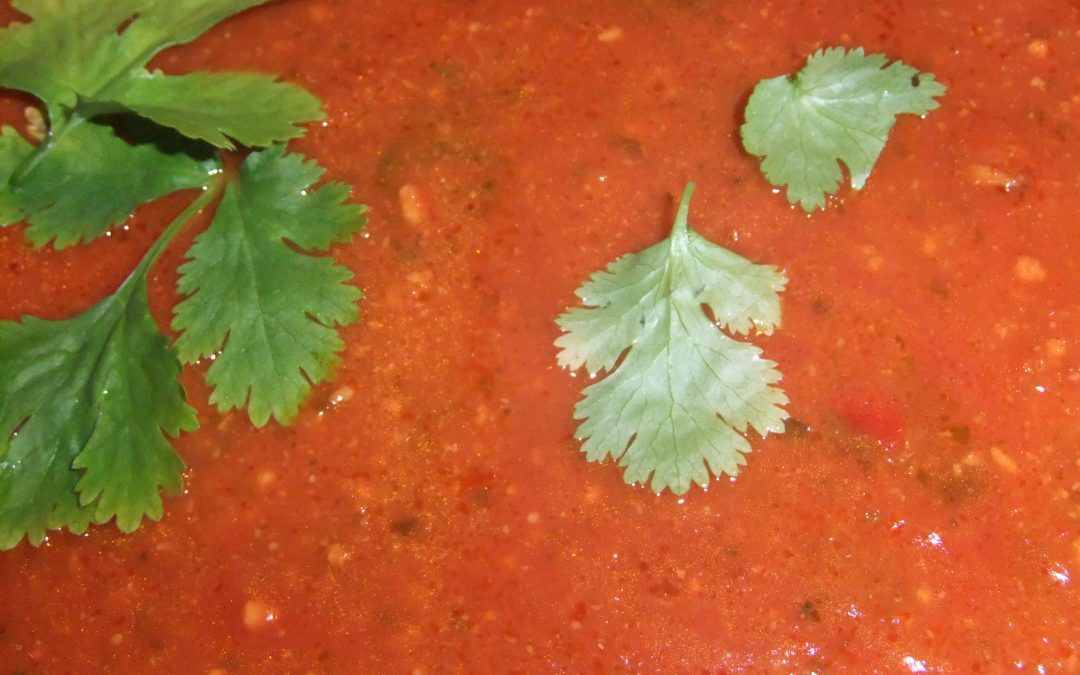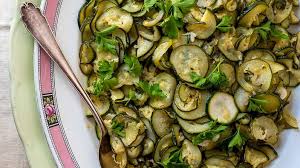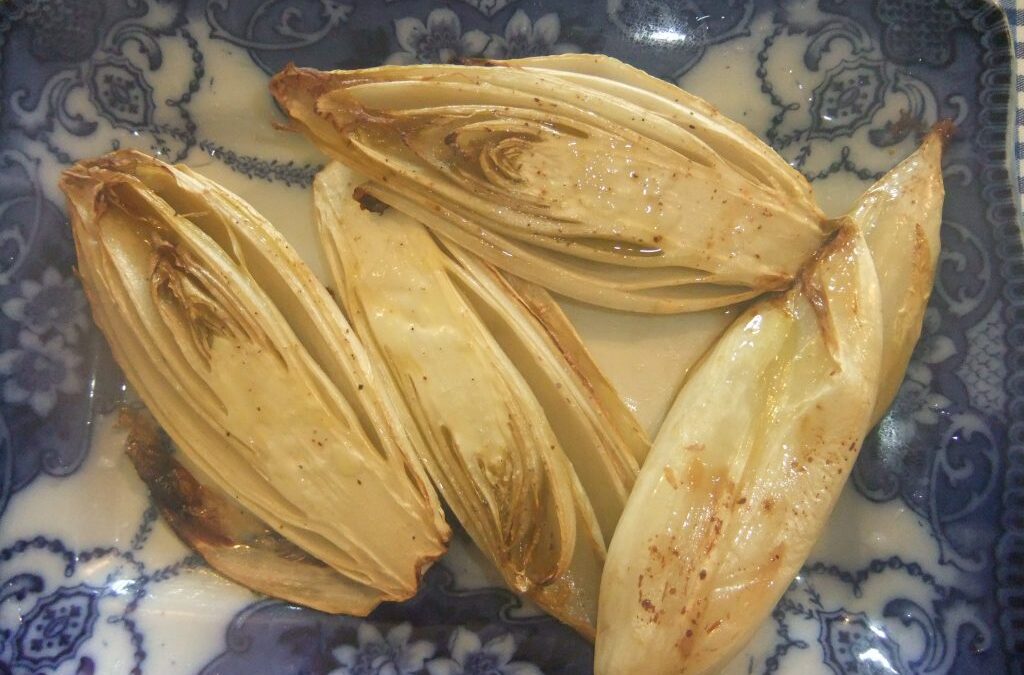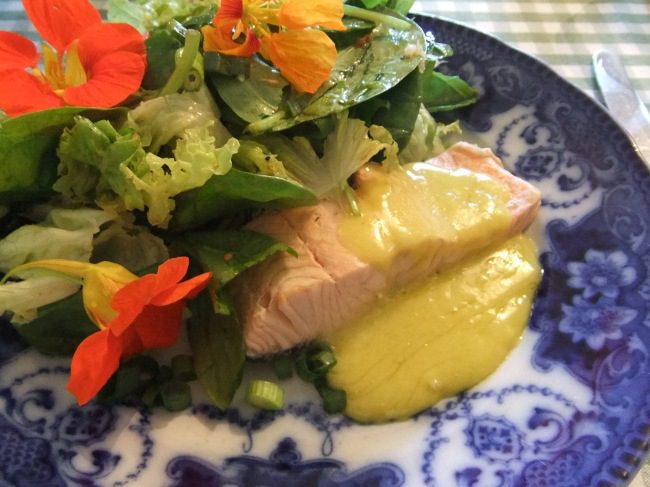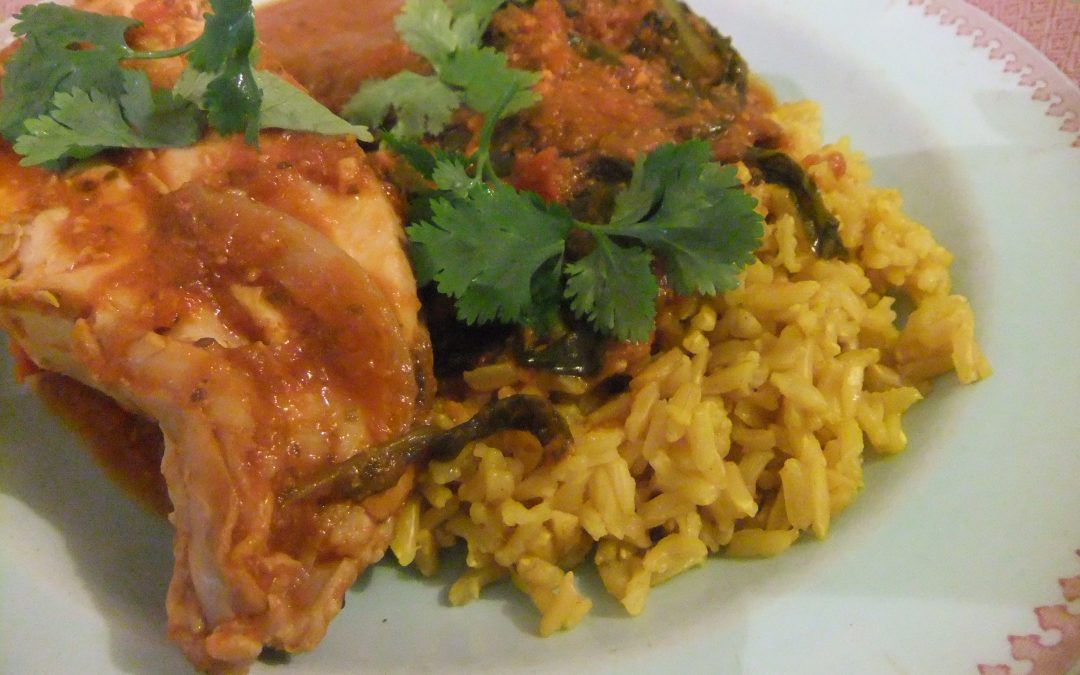
Oct 31, 2013 | Anna's Best Recipes, Dressings, rubs, spreads, sauces & more
This sauce makes a brilliant base in which to cook or heat vegetables, white fish, tofu, pre-cooked lamb, or cooked chickpeas. It also freezes well for future fast dinners. I have also posted my “Aromatic ginger, tomato & coconut chicken” recipe where I use this lovely sauce to cook chicken fillet and spinach.
For enough sauce for 2 people
Remember to check out my “larder & shopping” section for unusual ingredients
25g creamed coconut cut up roughly OR ½ cup of thick full-fat tinned coconut milk
3-4cm approx of fresh ginger root (enough to give 1 rounded dsp ginger when finely grated)
500g (500ml) bottle of passata (sieved tomatoes – from all supermarkets)
2 green chillies or ¼ teaspoon chilli powder (optional)
1 large handful fresh coriander if you have it
2 large garlic cloves
Version 1 (made with food processor or liquidiser)
1. Peel the garlic, de-seed the chillies (or if you like more heat leave them in), chop the ginger and coriander roughly and throw the lot into a small food processor. A food processor is preferable to jug liquidiser as if gets the ingredients ground up more quickly.
2. Add enough of the passata to get everything going and blitz until smooth.
3. Pour into a saucepan, add the rest of the passata and the creamed coconut or coconut milk and simmer for five minutes until the creamed coconut is melted and the sauce has slightly darkened. The sauce is now ready for use. Or cool and store in the fridge for a day or two until needed, or in the freezer.
Version 2 (without kitchen gadgets)
1. De-seed and chop the chillies, crush or finely chop the garlic, chop up the creamed coconut and the coriander roughly, finely grate the ginger.
2. Put all of this, with the passata, into a saucepan
3. Simmer for 5 minutes until the coconut is melted and the sauce has darkened a little. The sauce is now ready for use. Or cool and store in the fridge for a day or two until needed, or in the freezer.
Add green vegetables of your choice and cubes of raw chicken or fish, or cooked lamb or beef and simmer till everything is cooked. Here are some ideas to get you started:
- Chicken pieces and baby spinach (see recipe)
- Stir the following into the sauce and bubble, covered, until the veg are cooked but still crunchy, and the meat is heated through:
- 150 cooked, cubed lamb, 1 x 454g tin or mug of cooked, drained chickpeas, and 4 cups broccoli florets
- 1 1/2 x 450g tins or mugs of cooked, drained chickpeas plus 4 cups green beans cut into 4cm lengths
- 4 cups broccoli florets or 5cm lengths of runner beans and 300g bite-size cubes of firm white fish such as monkfish, lemon sole or coley
- If you are not wanting to lose weight, and are not following a ketogenic or paleo diet, you could also enjoy some brown rice on the side.
Why this recipe is good for you:
Processed tomatoes with no additives are a rich source of lycopene, an antioxidant that protects your skin from the damaging effects UV rays – like an edible sunblock! Your body absorbs lycopene better from pureed tomatoes than from whole tomatoes. Ginger, tomatoes, turmeric and chillies all have anti-inflammatory properties that are helpful for a healthy digestive system and good, clear skin. Non organic rice can be heavily contaminated with arsenic but fresh coriander bind to this and other toxic metals in your intestines, helping them be eliminated from your body. Spices like ginger and garlic help boost liver function, also to eliminate both natural and man-made toxins. Yet more reasons why herbs and spices are fantastic for you. Using passata packaged in glass jars or bottles means less exposure to toxic bisphenol A (BPA) , which is present in the plastic linings of cartons and tins. Scientific studies link BPA to hormonal imbalances such as low libido, endometriosis, fibroids, and hormone breast and prostate cancer) as well as osteoporosis. Limiting your exposure is good news.

Oct 31, 2013 | Anna's Best Recipes, Main courses
I ate this yesterday and enjoyed every bite. For a change I made it using chicken pieces on the bone (instead of bite size chicken pieces) and so then I cooked it for longer. The sauce of tomatoes, chillies, coriander, garlic and ginger also makes a brilliant cook-in sauce for vegetables, white fish, tofu, pre-cooked lamb, or cooked chickpeas. It also freezes well for future fast dinners.
For 2 people
Remember to check out my “larder & shopping” section for unusual ingredients
25g creamed coconut cut up roughly OR ½ cup of thick full-fat tinned coconut milk
3-4cm approx of fresh ginger root, peeled
500g (500ml) bottle of passata (sieved tomatoes – from all supermarkets)
2 green chillies or ¼ teaspoon chilli powder (optional)
1 large handful fresh coriander if you have it
2 large garlic cloves
2 skinless chicken fillets, ideally organic, cut into bite sized chunks
300g organic baby leaf spinach* or chard
Brown basmati rice (optional) plus ground turmeric for cooking.
Version 1 (made with food processor or liquidiser)
1. Peel the garlic, de-seed the chillies (or if you like your dish quite hot leave them in), chop the ginger and coriander roughly and throw the lot into a small food processor. A food processor is preferable to jug liquidiser as if gets the ingredients ground up more quickly.
2. Add enough of the passata to get everything going and blitz until smooth.
3. Pour into a saucepan, add the rest of the passata and the creamed coconut or coconut milk and simmer for a few minutes till the coconut is melted. Stir.
4. Add the chicken pieces and simmer till tender (about 10 mins)
5. Stir in the spinach, turn up the heat and cook until wilted (about 5 mins)
Version 2 (without kitchen gadgets)
1. De-seed and chop the chillies, crush or finely chop the garlic, chop up the creamed coconut and the coriander roughly, finely grate the ginger.
2. Put all of this, with the passata, into a saucepan
3. Simmer for a few mins until the creamed coconut melts, stirring occasionally.
4. Add chicken and simmer until tender (about 10 mins)
5. Stir in the spinach, turn up the heat and cook until wilted (about 5 mins).
*Conventional spinach is one of the most agri-chemical contaminated vegetables you can buy. If you cant get organic spinach then using chard, sliced green leeks, or steamed-til-tender broccoli or steamed green beans are good substitutions.
Serve with:
- Some steamed broccoli florets.
- If you are not wanting to lose weight and are not on a ketogenic or stoneage/paleo diet you could add (for 2 people):
Brown basmati rice (*boil ½ mug brown rice with 1 mug boiling water and ½ teaspoon ground turmeric, covered, till water is absorbed and rice is fluffed up).
Variation: If you prefer to leave your chicken fillets whole, simply cook for longer in the sauce (about 25 minutes) until cooked through, before adding the spinach for the last few minutes.
Why this recipe is good for you:
Processed tomatoes with no additives are a rich source of lycopene, an antioxidant that protects your skin from the damaging effects UV rays – like an edible sunblock! Your body absorbs lycopene better from pureed tomatoes than from whole tomatoes. Ginger, tomatoes, turmeric and chillies all have anti-inflammatory properties that are helpful for a healthy digestive system and good, clear skin. Non organic rice can be heavily contaminated with arsenic but fresh coriander bind to this and other toxic metals in your intestines, helping them be eliminated from your body. Spices like ginger help boost liver function, also to eliminate both natural and man-made toxins. Yet more reasons why herbs and spices are fantastic for you. Using passata packaged in glass jars or bottles means less exposure to toxic bisphenol A (BPA) , which is present in the plastic linings of cartons and tins. Scientific studies link BPA to hormonal imbalances such as low libido, endometriosis, fibroids, and hormone (e.g. breast and prostate cancer) as well as osteoporosis. Limiting your exposure is good news.

Aug 13, 2013 | Anna's Best Recipes, Sides, starters, soups & snacks
This is really simple and works hot, warm, or at room temperature, whichever you fancy. I like to eat this with grilled, poached, or baked fish. I invented this a few years ago but forgot about it until this summer’s heatwave. Good quality unrefined (i.e. cold-pressed) nut oil makes this super-delicious but if you can’t get it, extra virgin olive oil is fine – it just won’t have that nutty flavour.
For 2, as an accompaniment
2 large leeks, including the green parts
2 tbsp cold-pressed walnut or hazelnut oil (or extra virgin olive oil if you cant get nut oil)
2 tbs sherry vinegar (or red wine vinegar)
1 tbsp roughly chopped raw hazelnuts
Lots of freshly ground black pepper
A pinch of Himalayan or Atlantic Sea Salt
1. Cut the leeks in half at the point where the white meets the green part. Clean the green parts by separating the layers from each other and running under the tap to remove any grit. Wash the white parts too. Now cut everything into disks somewhere between half and three-quarters cm thick, just so long as they’re all approximately the same.
2. Steam over boiling water or in an electric steamer until wilted, checking frequently. Over boiling water, this will take maybe three minutes. You want the leeks slightly wilted but still bright green. When wilted, drain for a minute or two.
3. Empty the lot into a serving bowl, add the cold-pressed oil, vinegar, hazelnuts, and seasoning. Toss and serve.
Why this recipe is good for you:
Leeks are a rich source of inulin, which helps feed the good gut bacteria that are important for all aspects of our health – skin, immunity, digestion, and more. The green parts of all vegetables are rich in relaxing nutrient magnesium too – for brain, liver, and bowel health. Cold-pressed, raw nut and seed oils are a fantastic source of omega 6 oils, which we need to balance hormones and boost immunity. A typical Western diet today contains a large amount of refined omega 6 oils (all non-raw or non-cold-pressed/extra virgin nut and seed oils are refined). Consuming a lot of omega 6 oils containing -trans fats are linked to premature ageing, life-threatening disease, hormonal imbalance, low energy, and suppressed immunity. Raw-cold pressed nut and seed oils are best kept in an airtight glass bottle in the fridge to stop them from being damaged by oxygen and light and losing their health benefits. Extra virgin olive oil is more stable and can be kept in a dark cupboard. Dressing a salad with vinegar can help boost digestion.

Aug 6, 2013 | Anna's Best Recipes, Sides, starters, soups & snacks
This is an Italian technique for cooking courgettes which I learned as an au-pair in Rome a few decades ago. Thanks, Signora Pilato. It’s really simple but really lovely. It goes with nearly anything.
For 2:
4 medium courgettes
Extra virgin olive oil
2 cloves garlic
Black pepper
1. Put a heavy-bottomed frying pan on medium heat to warm while you peel the garlic cloves and slice them into quarters. Throw them into the pan with about a tablespoon of olive oil to soften slightly while you prepare the courgettes.
2. Wash the courgettes, slice them into disks of say 1/2 – 3/4 cm thick. You don’t have to be too precise here – it’s a rustic dish. Throw onto the pan, turn the heat down low, stir around to coat with the garlic and oil, and cover with a lid (or large plate). The lid is important because this means the courgettes will cook in the steam, rather then (unhealthily) frying and burning. The juices from the courgettes will stop everything from burning provided the heat is low enough. Stir from time to time to check everything is cooking but not burning. If it’s getting too brown, add a tiny amount of water and turn the heat down a little.
3. After about 15-20 mins, stirring occasionally, the courgettes will be softened and start to turn a little translucent and slightly browned in places. They are now done. Take off the heat and top with a few good grinds of black pepper and maybe a little more olive oil. It will stay warm, covered, in the pan, for quite a while.
Variation:
If you are feeling fancy and don’t need to avoid dairy, you could sprinkle some freshly grated parmesan over your courgettes after piling on your plate.
Why this dish is good for you:
Courgettes are a rich source of fibre and are a low-carbohydrate vegetable you can eat in unlimited quantities without gaining weight. Braising or steam-frying is a good, low-temperature way of cooking vegetables and tastes great.

Jul 28, 2013 | Anna's Best Recipes, Sides, starters, soups & snacks
I dreamed up this easy way with chicory this evening, to go with slow roast free-range pork. We also had my braised sliced courgettes alongside, which I will post shortly. The lovely bitterness of chicory cuts the fattiness of the pork, helping you digest it. You could also serve this as a starter, with a sprinkling of parmesan, or a tablespoon of chopped, raw walnuts.
For 2:
2 medium heads of chicory, treviso, or radicchio, rinsed, then halved lengthways
Extra virgin olive oil
Freshly ground black pepper
A pinch of Atlantic sea salt or Himalayan salt
Optional: 2 DSP freshly grated parmesan cheese (avoid for dairy-free)
- Preheat oven to 200C (fan 185).
- Place the chicory in a roasting tin, cut side up, and drizzle over about a dessert spoon of extra virgin olive oil.
- Roast for 15-20 minutes in the oven until wilted.
- Serve with a few good grinds of black pepper, a pinch of salt, and another drizzle of extra virgin olive oil. If you are feeling decadent, sprinkle a teaspoon of freshly grated parmesan over each half.
Why this is good for you:
Chicory, radicchio, and treviso are examples of foods that help you to digest a fatty meal. This is because their bitterness stimulates the flow of bile and digestive enzymes from your gallbladder. This helps break down (emulsify) fat into tiny droplets, which can then be digested all the easier by the digestive enzymes made in your pancreas and also in your small intestine. Other foods/drinks that do the same thing include dandelion coffee, dandelion leaves, rocket, and bitter apple sauce made from cooking apples.

Jul 25, 2013 | Anna's Best Recipes, Dressings, rubs, spreads, sauces & more
This is a traditional southern French garlic mayonnaise at its best. Always makes me think of holidays. The other day I ate a generous dollop on some poached salmon with a large salad with nasturtium flowers from the garden. Aioli is fantastic with poached or baked fish, cold meat, or hard-boiled eggs in a salad. If you like a more neutral-tasting mayo, you can use equal parts olive and a second cold-pressed (extra virgin) neutral-tasting oil such as sunflower or rapeseed. Do not use refined (non-cold-pressed) seed/nut oils as they are damaging to health. Aioli will keep for about 5 days in a glass jar in the coldest part of the fridge. The garlic helps preserve the raw eggs. It’s quicker to make aioli using an electric whisk than with the pestle and mortar. But don’t try to make it in a blender because it never thickens up for me using one!
For 4 servings:
3 cloves garlic
1 organic egg yolk, at room temperature (this helps the mixture not to “split” or separate)
150ml (approx) extra virgin olive oil (or half olive oil half raw cold-pressed sunflower or rape oil), also at room temperature
A pinch of Atlantic sea salt or Himalayan salt (optional)
You will need:
A pestle and mortar and/or an electric whisk
Pestle and mortar method:
- Peel the garlic, slice into slivers, and pound to a paste with a pinch of salt, add the egg yolk, and mix in. Pounding the garlic gives a different (and in my opinion, subtler) flavour from just crushing it with a garlic crusher.
- You can now either continue making the aioli with the pestle and mortar or (for less work) transfer the garlic/yolk mix to a bowl and get out your electric hand whisk before starting to add the oil as follows:
- Beat in the oil, at first drop by drop, and then, as the mix begins to thicken and resemble mayonnaise, add more liberally but never in a heavy stream. It is ready when it looks thick and creamy. See below for instructions on what to do if it goes wrong.
Electric whisk method:
1. Crush the garlic (with a garlic crusher if you have one, otherwise crush with the back of a knife, using a pinch of salt to really grind up the garlic). Add to a bowl.
2. Add the egg yolk and whisk with an electric whisk for a minute.
3. Beat in the oil, at first drop by drop, and then, as the mix begins to thicken and resemble mayonnaise, add more liberally but never in a heavy stream. If you add it too quickly the mixture will split and never thicken. It is ready when it looks thick and creamy.
To rescue “split” aioli:
Get a fresh (room temperature) egg yolk and start beating it. While beating, VERY gradually and a drop at a time, start adding in the “split” mixture as if it were just oil. Very gradually incorporate the split mixture into the egg yolk, beating continuously, until you have a thick, creamy aioli.
Variations:
Add the zest of an organic lemon and 1 tbsp fresh lemon juice to room-temperature aioli (if it’s not at room temperature, adding the lemon juice will make it split). Mix well. You could also add 2 tbsp chopped parsley too.
Why this is good for you:
Cold-pressed raw oils are fantastic for your health! The raw oils from sunflower, rape, and sesame are rich in polyunsaturated omega 6 oils, while extra virgin olive oil is high in monounsaturated oils and vitamin E, a powerful antioxidant. Omega 6 is fine in small amounts whereas you can enjoy unlimited extra virgin olive oil. These oils can help weight management, enhance skin health and also moisturize your skin from within. You will need to keep raw cold-pressed nut/seed oils in the fridge as they are fragile and easily go off, losing their health benefits. Refined or fried oils (all supermarket oils except extra virgin olive and cold-pressed rapeseed oil and extra virgin coconut oil) disrupt hormone balance and contribute to weight gain and visible aging. Studies have shown people lose weight when they ADD extra virgin olive oil (and raw nuts) to their diets! High-quality oils make you feel fuller longer. Never cook with polyunsaturated oils, only use them raw and cold-pressed.

Jul 22, 2013 | Anna's Best Recipes, Main courses
Tonight, we ate these gorgeous chicken pieces. Instead of the roast Mediterranean veg in the recipe, we piled them onto a bed of baby spinach leaves alongside green beans dressed with lemon juice, black pepper, and a little Himalayan salt. If you don’t want to lose any weight, you could add some potatoes. This way of roasting chicken pieces is a real crowd-pleaser.
The paste keeps for a couple of weeks in an airtight jar in the fridge. The chicken is even better if you let it sit in the paste for a while or overnight in the fridge. It’s still great if you slather it on just before cooking. Using a miniature food processor gives a really creamy texture to the paste and saves lots of effort.
For 2
2 whole chicken legs, small breasts on the bone, or fillets, ideally organic.
2 whole red or yellow peppers, washed but not cut open
2 large fat courgettes
A few small/medium sized sweet potatoes or normal potatoes in their jackets (optional – omit if this is your evening meal and you want to lose weight or if you are following a ketogenic eating plan)
2 red onions (optional)
Garlic-spice paste:
12 large cloves garlic, peeled
3 tbsp extra virgin olive oil
1 lemon, juiced
1 level tsp ground cinnamon
¾ teasp ground allspice
¼ teasp freshly ground black pepper
A good pinch of cayenne pepper
1. Preheat the oven to 200C/400F/gm 6
2. Blitz all the spice paste ingredients together in a small food processor. Otherwise crush the garlic and mix well with the other ingredients – the sauce will not cling so well but is still fine.
3. Slather enough of the paste on the chicken to coat well and place in a large roasting dish (you will have a fair bit left over to drizzle over baked sweet potatoes, to use another time to grill some white fish, or to serve as a spicy accompaniment )
4. Prepare whatever vegetables you are using: Wash the peppers (do not cut anything out as, cooked whole, the pepper will fill up with delicious sweet juices while cooking); wash the courgettes and cut into 7cm lengths;
Scrub the potatoes if using. Peel and halve the red onions if using and brush with a little olive oil
Spread out the veg in a single layer with the chicken in the roasting dish.
5. Bake for 50 mins in the oven or until the chicken juices run clear when the meat is pierced with the point of a knife. Chicken fillets may cook faster if they are small so check these after 30 mins (remove from the oven if done while the rest of the veg finish cooking).
Cook’s Tip for Kids Eating:
Many children dislike seeing seeds so try halving the peppers, removing the seeds and in each pepper place a tomato half and a teaspoon of olive oil before putting in the oven. This helps the pepper avoid drying out.
Dietary note:
Garlic and spices in your diet are a fantastic health booster – for liver and skin health, immunity and delaying the effects of ageing. If you cannot source organic chicken then its best to avoid fattiest part of the bird (legs, thighs, skin) and eat only the breast. Battery chickens are routinely dusted with pesticides which congregate in the fatty tissues of the bird.

Jul 19, 2013 | Anna's Best Recipes, Main courses
We made this on Wednesday night using leftovers from the pot roast chicken we cooked on Monday. We doubled up the quantities so as to have effortlessly packed lunches the following day. Spouse was ravenous so I cooked an extra 60g of brown rice noodles (which I dressed with a little tamari sauce and a teaspoon of cold-pressed sesame oil) for him as a side. This recipe is suitable for a ketogenic diet if you omit syrup, coconut sugar, or xylitol. If you have a problem with raw onions, try soaking them in the dressing for 20 minutes before adding the other ingredients, this takes the heat out of them.
For 2:
160g cooked chicken (organic if possible), shredded or sliced
4 cups raw, shredded cabbage red, white or green
1 medium carrot, cut into strips with a potato peeler or julienned (in thin matchsticks)
3 spring onions, including green part, cut into long thin strips OR 1/2 a medium/large red onion, halved, then sliced thinly
2 tbsp coarsely chopped or torn mint leaves
Mint and coriander sprigs to garnish
Dressing
1 tbsp fresh lime juice
1 tbsp oriental fish sauce
1 tsp white wine vinegar or rice vinegar if you have it
1 crushed clove garlic
1 DSP coconut sugar, agave or maple syrup, or xylitol (optional) (omit for ketogenic diet)
1 tbsp cold-pressed (virgin) sesame/peanut/sunflower/macadamia/rapeseed oil (if you cannot get any of these as the cold-pressed oil, do not use any oil at all)
1 red chili, de-seeded and finely chopped (optional)
1. For the dressing: put the lime juice, fish sauce, vinegar, garlic & coconut sugar, syrup or xylitol, oil, and chilies in a bowl and whisk so the sugar/xylitol dissolves. Leave for 30 minutes for the flavours to develop.
2. Mix in the salad ingredients and divide between 2 plates or bowls.
3. Garnish with mint and coriander sprigs.
If this is your evening meal and you’re not wanting to lose weight, serve with brown rice or 100% buckwheat or brown rice noodles sprinkled with a little Tamari sauce (from Asian shops). Omit noodles for a ketogenic diet.
Dietary note:
Tamari is a delicious, naturally gluten-free soya sauce, and buckwheat and brown rice are naturally gluten-free too. Cabbage contains folic acid and cabagin which are both very healing for the digestive system, especially if you have gastritis or ulcers. Surprisingly, chilies can have a pain-relieving effect on ulcers and are used in ayurvedic medicine as an ulcer treatment. The virgin, cold-pressed nut and seed oils mentioned in the recipe, eaten raw, are a rich source of omega 6 essential fats. Essential fats are needed for clear skin, digestive wellness, and energy production. Trans fats, generated during standard (non-cold) processing of oils and also during cooking, are harmful. They damage the body and block essential fat utilization. Herbs and spices are high in antioxidants for many health benefits. The reason some people do not tolerate raw onions is they relax the esophageal sphincter. This is the valve that stops food from coming back up towards your gullet. If you have acid reflux, it means that this valve could do with being strengthened by specific dietary measures.
